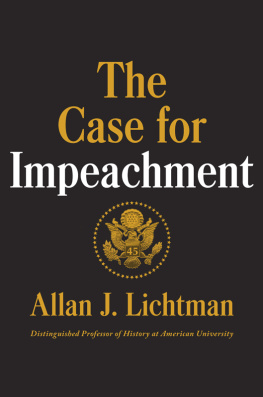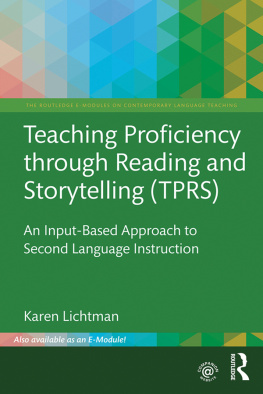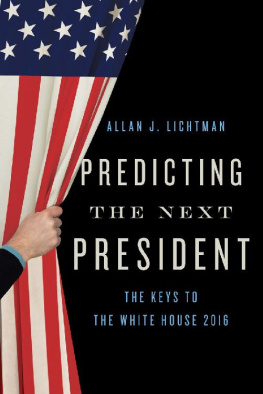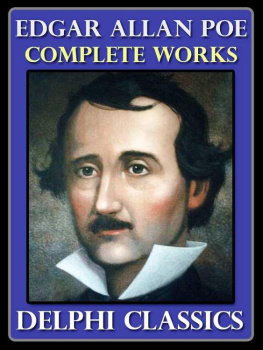Allan J. Lichtman - Predicting the Next President
Here you can read online Allan J. Lichtman - Predicting the Next President full text of the book (entire story) in english for free. Download pdf and epub, get meaning, cover and reviews about this ebook. year: 2020, publisher: Rowman & Littlefield Publishers, genre: Politics. Description of the work, (preface) as well as reviews are available. Best literature library LitArk.com created for fans of good reading and offers a wide selection of genres:
Romance novel
Science fiction
Adventure
Detective
Science
History
Home and family
Prose
Art
Politics
Computer
Non-fiction
Religion
Business
Children
Humor
Choose a favorite category and find really read worthwhile books. Enjoy immersion in the world of imagination, feel the emotions of the characters or learn something new for yourself, make an fascinating discovery.

- Book:Predicting the Next President
- Author:
- Publisher:Rowman & Littlefield Publishers
- Genre:
- Year:2020
- Rating:5 / 5
- Favourites:Add to favourites
- Your mark:
- 100
- 1
- 2
- 3
- 4
- 5
Predicting the Next President: summary, description and annotation
We offer to read an annotation, description, summary or preface (depends on what the author of the book "Predicting the Next President" wrote himself). If you haven't found the necessary information about the book — write in the comments, we will try to find it.
Predicting the Next President — read online for free the complete book (whole text) full work
Below is the text of the book, divided by pages. System saving the place of the last page read, allows you to conveniently read the book "Predicting the Next President" online for free, without having to search again every time where you left off. Put a bookmark, and you can go to the page where you finished reading at any time.
Font size:
Interval:
Bookmark:
How is it possible to predict the winners of presidential elections without recourse to the pollssometimes in direct contradiction of themand without knowing how the campaign would be conducted, what the salient issues would be, or how candidates would fare in televised debates?
The answer is that presidential elections do not work the way most people think they do. Contrary to assumptions made by pollsters, pundits, and political experts who track presidential campaigns, our quadrennial contests for executive power are not contests at all. They do not pit one candidates popularity, leadership ability, positions on the issues, or vision against anothers. They do not turn on the party loyalties of voters, their devotion to liberal or conservative ideologies, or their perception of which candidate is closer to the center of the political spectrum. The electorate does not simply vote its pocketbook, retaining the party in power in good times and throwing the rascals out in bad. Elections certainly are not horse races in which candidates surge ahead or fall behind as they sprint toward Election Day.
Presidential elections are primarily referenda on the performance of the incumbent administration during the previous four years. That is the verdict disclosed by the keys to the White House, a diagnostic prediction system developed through the application of mathematical procedures to the study of presidential elections since 1860. This unique method of historical inquiry reveals what events past and present really have in common, freeing forecasters from ad hoc and often erroneous lessons of history. Embodying a broad-based performance theory of presidential elections, this prediction system identifies thirteen historical conditions, or keys, that gauge the political strength and performance of the executive party as a presidential term progresses. The keys measure an incumbent partys reelection prospects long before polls, pundits, or political scientists have anything meaningful to say.
Each of the thirteen keys (see page 3) asks a question that can be answered yes or no before an upcoming election. To avoid the confusion of double negatives, the keys are stated as threshold conditions that favor reelection of the incumbent party. When five or fewer keys are false, the incumbent party wins the popular vote; when six or more are false, the challenging party prevails.
The principal historical lesson to be drawn from the keys is that the fate of an incumbent administration rests largely in its own hands; there is little that the challenging party can do to affect the outcome of an election. If the nation has fared well during the term, the executive party is reelected; if not, the White House changes hands. But such simple notions as peace and prosperity do not adequately measure an administrations success or failure. The keys to the White House gauge the multiple dimensions of incumbent strength and performance that together identify the point at which the party in power crosses the line separating victory from defeat.
Nothing either party has said or done during the fall campaign has ever changed its prospects at the polls. Debates, television appearances, fund-raising, advertising, news coverage, and campaign strategiesthe usual grist for the punditry millscount for virtually nothing on Election Day. The only issues that matter are the ones for which the results are already in.
Because the keys to the White House diagnose the national political environment, they correlate with the popular balloting, not with the votes of individual states. Only three times since 1860, however, has the electoral college not ratified the popular vote: the stolen election of 1876, when Democrat Samuel J. Tilden outpolled Republican Rutherford B. Hayes 51 to 48 percent but lost a disputed contest for the electoral vote; the election of 1888, when electoral college votes overrode President Grover Clevelands narrow popular-vote margin over Benjamin Harrison; and the 2000 election described above.
Each of the keys expresses a condition associated with incumbent-party success, but only in combination do they accurately predict the outcome of an election. The first four keysthe political keysprimarily gauge the strength and unity of the incumbent party, whereas keys 5 through 11the seven performance keysmeasure its perceived achievements and failures across a broad range of concerns. The final two keysthe charisma keysrecognize that personality makes a difference in presidential politics, but the difference is critical only when a candidate is either unusually compelling or of heroic stature.
The keys to the White House are stated as conditions that favor reelection of the incumbent party. When five or fewer statements are false, the incumbent party wins. When six or more are false, the incumbent party loses.
KEY 1 Incumbent-party mandate: After the midterm elections, the incumbent party holds more seats in the U.S. House of Representatives than it did after the previous midterm elections.
KEY 2 Nomination contest: There is no serious contest for the incumbent-party nomination.
KEY 3 Incumbency: The incumbent-party candidate is the sitting president.
KEY 4 Third party: There is no significant third-party or independent campaign.
KEY 5 Short-term economy: The economy is not in recession during the election campaign.
KEY 6 Long-term economy: Real annual per capita economic growth during the term equals or exceeds mean growth during the two previous terms.
KEY 7 Policy change: The incumbent administration effects major changes in national policy.
KEY 8 Social unrest: There is no sustained social unrest during the term.
KEY 9 Scandal: The incumbent administration is untainted by major scandal.
KEY 10 Foreign or military failure: The incumbent administration suffers no major failure in foreign or military affairs.
KEY 11 Foreign or military success: The incumbent administration achieves a major success in foreign or military affairs.
KEY 12 Incumbent charisma: The incumbent-party candidate is charismatic or a national hero.
KEY 13 Challenger charisma: The challenging-party candidate is not charismatic or a national hero.
Armed with the keys and knowledge of how they have been turned in the past (see ), anyone can analyze the electoral prospects of an incumbent party throughout a presidential term. The individual keys begin lining up the day after an election; although most cannot be turned with certainty until the election year, many can be reasonably anticipated much earlier. The keys provide a long-range outlook on the incumbent partys reelection prospects and indicate precisely how those prospects would change in response to specific circumstances and events. They are an electoral road map to the four years of a presidential term.
After Ronald Reagan had been in office only a year, for example, the keys already disclosed his superior prospects for reelection in 1984. In the spring of 1988, eight months before the election, the Republican administration had enough keys in place to make George W. Bush a shoo-in for reelection. In 1990, when most commentators were bullish about Bushs reelection prospects, the keys indicated that Bush looks more like a Carter than a Reagan.
The keys correctly anticipated even the closest elections in American history. James A. Garfield faced a deficit of four keys when he beat Winfield Scott Hancock by only two thousand votes in 1880a margin of victory of less than one-tenth of 1 percent, by far the narrowest in history. Four years later, James G. Blaine, the nominee of the incumbent Republican Party, lost seven keys in his 26,000-vote loss to Grover Cleveland. More recently, John F. Kennedys eyelash winby less than two-tenths of a percentage pointover Richard Nixon in 1960 was clearly anticipated by the GOPs nine-key deficit.
Font size:
Interval:
Bookmark:
Similar books «Predicting the Next President»
Look at similar books to Predicting the Next President. We have selected literature similar in name and meaning in the hope of providing readers with more options to find new, interesting, not yet read works.
Discussion, reviews of the book Predicting the Next President and just readers' own opinions. Leave your comments, write what you think about the work, its meaning or the main characters. Specify what exactly you liked and what you didn't like, and why you think so.







